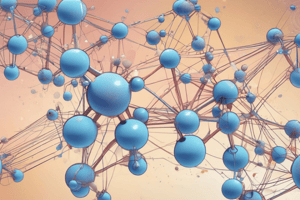Podcast
Questions and Answers
Which type of diuretic is most commonly used for reducing hypertension by inhibiting the Na+/Cl- symporter?
Which type of diuretic is most commonly used for reducing hypertension by inhibiting the Na+/Cl- symporter?
- Osmotic Diuretics
- Loop Diuretics
- Thiazides (correct)
- Potassium-Sparing Diuretics
What is the primary mechanism of action for vitamin K antagonists like Warfarin?
What is the primary mechanism of action for vitamin K antagonists like Warfarin?
- Promote fibrinolysis
- Enhance platelet aggregation
- Directly inhibit thrombin
- Inhibit synthesis of clotting factors (correct)
Which class of anti-hyperlipidemic agents works by enhancing LDL receptor recycling to lower LDL cholesterol?
Which class of anti-hyperlipidemic agents works by enhancing LDL receptor recycling to lower LDL cholesterol?
- Niacin
- Fibrates
- Statins
- PCSK9 Inhibitors (correct)
What is the main action of local anesthetics in blocking sensation?
What is the main action of local anesthetics in blocking sensation?
Which of the following classes of anti-diabetic agents primarily improves insulin sensitivity?
Which of the following classes of anti-diabetic agents primarily improves insulin sensitivity?
What is the role of analog synthesis in the context of structure-activity relationships (SAR)?
What is the role of analog synthesis in the context of structure-activity relationships (SAR)?
Which anticoagulant specifically targets factor Xa?
Which anticoagulant specifically targets factor Xa?
Which drug is a thiazide diuretic commonly used in clinical practice?
Which drug is a thiazide diuretic commonly used in clinical practice?
Which of the following is a common adverse effect of statins?
Which of the following is a common adverse effect of statins?
What is the primary benefit of using potassium-sparing diuretics?
What is the primary benefit of using potassium-sparing diuretics?
Flashcards are hidden until you start studying
Study Notes
Medicinal Chemistry
Structure-Activity Relationships (SAR)
- Definition: Relationship between chemical structure of compounds and their biological activity.
- Key Concepts:
- Changes in structure can alter potency and specificity.
- Functional groups influence interaction with biological targets.
- 3D conformation affects binding affinity.
- Analog synthesis can be used to refine drug properties.
Diuretics
- Function: Promote the excretion of water and electrolytes.
- Types:
- Thiazides: Inhibit Na+/Cl- symporter; reduce hypertension.
- Loop Diuretics: Act on the Loop of Henle; potent, used in heart failure.
- Potassium-Sparing: Inhibit aldosterone; retain potassium.
- Common Drugs: Hydrochlorothiazide, Furosemide, Spironolactone.
Anticoagulants
- Function: Prevent blood coagulation, reducing thrombus formation.
- Mechanisms:
- Vitamin K Antagonists: Inhibit synthesis of clotting factors (e.g., Warfarin).
- Direct Oral Anticoagulants (DOACs): Target specific factors (e.g., Dabigatran - thrombin, Rivaroxaban - factor Xa).
- Clinical Uses: Manage atrial fibrillation, deep vein thrombosis.
Anti-Hyperlipidemic Agents
- Function: Lower lipid levels in the blood to prevent cardiovascular disease.
- Classes:
- Statins: Inhibit HMG-CoA reductase; reduce cholesterol synthesis (e.g., Atorvastatin).
- Fibrates: Increase lipoprotein lipase; lower triglycerides (e.g., Fenofibrate).
- PCSK9 Inhibitors: Enhance LDL receptor recycling; lower LDL cholesterol.
- Mechanism: Different pathways for cholesterol and triglyceride reduction.
Local Anesthetics
- Function: Block nerve conduction to produce temporary loss of sensation.
- Mechanism:
- Block voltage-gated sodium channels; prevent action potential generation.
- Common Agents: Lidocaine, Bupivacaine, Procaine.
- Uses: Surgical procedures, dental work, pain management.
Anti-Diabetic Agents
- Function: Manage blood glucose levels in diabetes mellitus.
- Classes:
- Insulin: Hormonal therapy for Type 1 diabetes and some Type 2.
- Biguanides: Improve insulin sensitivity (e.g., Metformin).
- Sulfonylureas: Stimulate insulin secretion from the pancreas.
- DPP-4 Inhibitors: Enhance incretin levels, improving insulin action.
- Key Concepts: Importance of monitoring glycemic control and side effects.
Structure-Activity Relationships (SAR)
- The relationship between the chemical structure of compounds and their biological activity.
- Changes in molecular structure can significantly impact a compound's potency and specificity.
- Specific functional groups can influence the interaction with biological targets.
- The 3D conformation of a molecule affects its binding affinity to its target
- Analog synthesis, the systematic modification of a compound's structure, is a valuable tool for refining drug properties.
Diuretics
- Promote the excretion of water and electrolytes from the body.
- Thiazides inhibit the Na+/Cl- symporter, decreasing sodium reabsorption and reducing hypertension.
- Loop diuretics act on the Loop of Henle, powerfully promoting fluid excretion, commonly used for heart failure.
- Potassium-sparing diuretics inhibit aldosterone, promoting potassium retention and sodium excretion.
- Examples include hydrochlorothiazide, furosemide, and spironolactone.
Anticoagulants
- Prevent blood coagulation, reducing thrombus (blood clot) formation.
- Vitamin K antagonists, like warfarin, inhibit the synthesis of clotting factors, ultimately slowing coagulation.
- Direct oral anticoagulants (DOACs) target specific factors in the clotting cascade, like Dabigatran (thrombin) and Rivaroxaban (factor Xa) offering more targeted and predictable anticoagulation.
- Clinical uses include management of atrial fibrillation and deep vein thrombosis.
Anti-Hyperlipidemic Agents
- Lower lipid levels in the blood to prevent cardiovascular disease.
- Statins, such as atorvastatin, inhibit HMG-CoA reductase, an enzyme essential for cholesterol synthesis.
- Fibrates like fenofibrate increase lipoprotein lipase activity, lowering triglyceride levels.
- PCSK9 inhibitors, a newer class, enhance LDL receptor recycling, leading to reduced LDL cholesterol.
- Each class targets different pathways within lipid metabolism for effective lipid reduction.
Local Anesthetics
- Block nerve conduction to produce temporary loss of sensation.
- Blockage of voltage-gated sodium channels in cell membranes prevents action potential generation, thus halting nerve impulse transmission.
- Common agents include lidocaine, bupivacaine, and procaine.
- Used in various settings: surgical procedures, dental work, pain management.
Anti-Diabetic Agents
- Manage blood glucose levels in individuals with diabetes mellitus.
- Insulin, a hormonal therapy, is the primary treatment for type 1 diabetes and certain cases of type 2 diabetes.
- Biguanides, like metformin, enhance insulin sensitivity, improving glucose utilization.
- Sulfonylureas stimulate insulin secretion from the pancreas.
- DPP-4 inhibitors enhance incretin levels, hormones that promote insulin action and reduce glucagon secretion.
- Continuous monitoring of glycemic control and awareness of side effects are crucial for effective diabetes management.
Studying That Suits You
Use AI to generate personalized quizzes and flashcards to suit your learning preferences.




